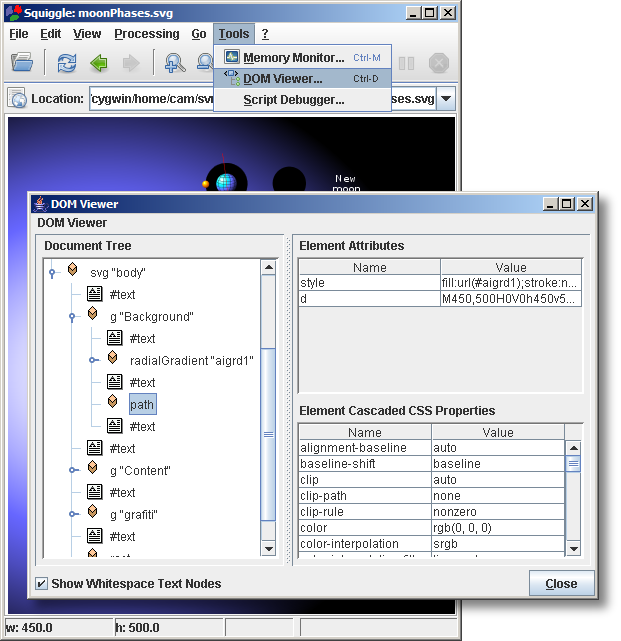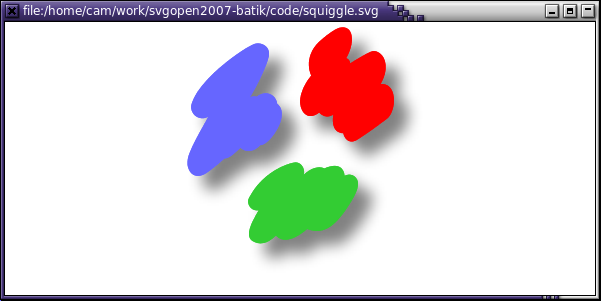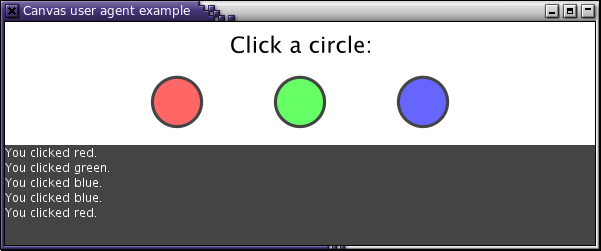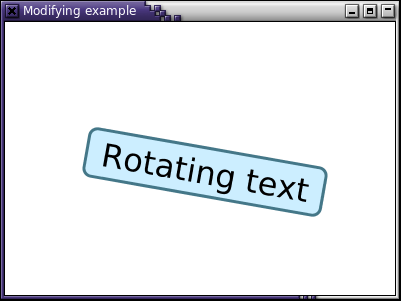Using the Apache Batik toolkit for client- and server-side SVG processing
September 4, 2007
Introduction
-
What is Batik?
- Tools
- Squiggle - Rasterizer - Font converter
- Modules
-
SVG DOM - SVG microsyntax parsers
Scripting module - Swing SVG component
SVG generator - Transcoder
Squiggle, an example SVG browser

Features of Squiggle
- (Mostly) conforming dynamic SVG 1.1 viewer
- DOM viewer
- Integrated ECMAScript debugger
- Raster image exporter (PNG, JPEG, TIFF)
- Supports a couple of assorted SVG 1.2 features
- Upcoming enhancements to the DOM viewer and a new animation timeline viewer from Google Summer of Code students Ivan Andjelkovic and Jasleen Singh
JSVGCanvas
- Interactive Swing SVG viewing component
- Specify a URI or DOM tree to display
- Built-in navigation interactors

Simple use of JSVGCanvas
// A canvas to show "squiggle.svg"
JSVGCanvas c = new JSVGCanvas();
String uri = new File("squiggle.svg").toURI().toString();
c.setURI(uri);
// A frame for the canvas to live in
JFrame f = new JFrame(uri);
f.setSize(600, 300);
f.setDefaultCloseOperation(JFrame.EXIT_ON_CLOSE);
// Add the canvas to the frame
f.getContentPane().add(c);
// Show the frame
f.setVisible(true);JSVGCanvas constructors
JSVGCanvas(SVGUserAgent ua, boolean eventsEnabled, boolean selectableText)-
ua — Object that provides the canvas with access to the “outside world”
eventsEnabled — Whether UI interactions will dispatch DOM events
selectableText — Whether text in SVG documents can be highlighted with the mouse
JSVGCanvas()- Same as
JSVGCanvas(null, true, true).
The SVGUserAgent interface
String getDefaultFontFamily()- The font to use when none is specified.
String getLanguages()- List of natural languages the user prefers.
String getPixelUnitToMillimeter()- Controls how length units translate to pixels.
String getUserStyleSheetURI()- User CSS style sheet.
void openLink(String uri, boolean newc)- Invoked when a link is clicked.
void showAlert(String message)- Invoked when script calls
alert(). - …
Supplying a user agent object
- We want
alert()ed messages to go to aJTextArea.

<text x='300' y='50' font-size='36' text-anchor='middle'>Click a circle:</text>
<g stroke='#444' stroke-width='5'>
<circle cx='100' cy='130' r='40' fill='#f66' onclick='alert("You clicked red.")'/>
<circle cx='300' cy='130' r='40' fill='#6f6' onclick='alert("You clicked green.")'/>
<circle cx='500' cy='130' r='40' fill='#66f' onclick='alert("You clicked blue.")'/>
</g>Supplying a user agent object
// A text area for messages
final JTextArea t = new JTextArea();
t.setPreferredSize(new Dimension(600, 100));
…
// A user agent object
SVGUserAgent ua = new SVGUserAgentAdapter() {
public void showAlert(String message) {
t.append(message + "\n");
}
};
// A canvas to show "circles.svg"
JSVGCanvas c = new JSVGCanvas(ua, true, false);
String uri = new File("circles.svg").toURI().toString();
c.setURI(uri);
// A frame for the canvas to live in
JFrame f = new JFrame(uri);
f.getContentPane().setLayout(new BorderLayout());
f.getContentPane().add(c);
f.getContentPane().add(t, BorderLayout.SOUTH);
…Interactors
- React to AWT UI events on a JSVGCanvas
- UI events aren’t passed on to the document
- Implement
org.apache.batik.swing.gvt.Interactorinterface Interactor extends KeyListener, MouseListener, MouseMotionListener { boolean startInteraction(InputEvent ie); boolean endInteraction(); }
Writing an interactor
- We want to center the canvas on a double click

Writing an interactor
public class CenteringInteractor extends InteractorAdapter {
protected boolean isDoubleClick(InputEvent ie) {
if (ie instanceof MouseEvent) {
MouseEvent me = (MouseEvent) ie;
return me.getID() == MouseEvent.MOUSE_CLICKED
&& me.getButton() == MouseEvent.BUTTON1
&& me.getClickCount() == 2;
}
return false;
}
public boolean startInteraction(InputEvent ie) {
return isDoubleClick(ie);
}
public boolean endInteraction() {
return true;
}
...
Writing an interactor
public void mouseClicked(MouseEvent me) {
if (isDoubleClick(me)) {
JSVGCanvas c = (JSVGCanvas) me.getSource();
int cx = c.getWidth() / 2;
int cy = c.getHeight() / 2;
int x = me.getX();
int y = me.getY();
AffineTransform at =
AffineTransform.getTranslateInstance(cx - x, cy - y);
AffineTransform rt =
(AffineTransform) c.getRenderingTransform().clone();
rt.preConcatenate(at);
c.setRenderingTransform(rt);
}
}
}
JSVGCanvas c = ...;
c.getInteractors().add(new CenteringInteractor());Overlays
- Extra graphics painted above the canvas
- Implement
org.apache.batik.swing.gvt.Overlayinterface Overlay { void paint(Graphics g); }
Writing an overlay
- We want the map example to have a symbol marking the centre

Writing an overlay
public class CentreSymbolOverlay implements Overlay {
protected JSVGCanvas canvas;
public CentreSymbolOverlay(JSVGCanvas canvas) {
this.canvas = canvas;
}
public void paint(Graphics g) {
Graphics2D g2d = (Graphics2D) g;
int w = canvas.getWidth();
int h = canvas.getHeight();
g2d.setColor(Color.BLACK);
g2d.setStroke(new BasicStroke(2f));
g2d.drawRect(w / 2 - 10, h / 2 - 10, 20, 20);
g2d.drawLine(w / 2, h / 2 - 13, w / 2, h / 2 - 7);
g2d.drawLine(w / 2, h / 2 + 7, w / 2, h / 2 + 13);
g2d.drawLine(w / 2 - 13, h / 2, w / 2 - 7, h / 2);
g2d.drawLine(w / 2 + 7, h / 2, w / 2 + 13, h / 2);
}
}
JSVGCanvas c = ...;
c.getOverlays().add(new CentreSymbolOverlay(c));Using the SVG DOM
- An implementation of DOM Level 3 Core, DOM Level 3 Events (draft) and the SVG 1.1 DOM
- Allows construction and manipulation of DOM trees representing SVG documents
- Also has SVG specific functionality
Creating a document using the DOM
- In a generic DOM implementation, to create a document you:
- Get an instance of
org.w3c.dom.DOMImplementationsomehow - Call
createDocument()on theDOMImplementationobject to create a new object that implementsorg.w3c.dom.Document - Call various methods on the
Documentobject and other newly created nodes to build the document
- Get an instance of
- In Batik, the
DOMImplementationobject is obtained usingorg.apache.batik.dom.svg.SVGDOMImplementation .getDOMImplementation()
Creating a document using Batik
- We want to construct this document from scratch:
<svg xmlns='http://www.w3.org/2000/svg' width='400' height='450'> <rect x='10' y='20' width='100' height='50' fill='red'/> </svg>
Creating a document using Batik
// Get a DOMImplementation object
DOMImplementation impl = SVGDOMImplementation.getDOMImplementation();
// Create a new document
String svgNS = SVGDOMImplementation.SVG_NAMESPACE_URI;
Document doc = impl.createDocument(svgNS, "svg", null);
// Get the root element (the 'svg' element).
Element svgRoot = doc.getDocumentElement();
// Set the width and height attributes on the root 'svg' element.
svgRoot.setAttributeNS(null, "width", "400");
svgRoot.setAttributeNS(null, "height", "450");
// Create the rectangle.
Element rectangle = doc.createElementNS(svgNS, "rect");
rectangle.setAttributeNS(null, "x", "10");
rectangle.setAttributeNS(null, "y", "20");
rectangle.setAttributeNS(null, "width", "100");
rectangle.setAttributeNS(null, "height", "50");
rectangle.setAttributeNS(null, "fill", "red");
// Attach the rectangle to the root 'svg' element.
svgRoot.appendChild(rectangle);Creating a document by parsing XML
- We can parse XML from a file or from a string
- The
SAXSVGDocumentFactoryclass does the parsing -
Supply it with a URI,
InputStreamorReadercreateDocument(String uri)createDocument(String uri, InputStream inp)createDocument(String uri, Reader r)
- The new
Documentobjects are alsoorg.w3c.dom.svg.SVGDocuments
Creating a document by parsing XML
String theXML = "<svg xmlns='http://www.w3.org/2000/svg' width='400' ...";
try {
String parser = XMLResourceDescriptor.getXMLParserClassName();
SAXSVGDocumentFactory f = new SAXSVGDocumentFactory(parser);
// Construct a document from XML in a string
StringReader r = new StringReader(theXML);
Document doc1 = f.createDocument(r);
// Construct a document from XML at a URI
String uri = "http://xmlgraphics.apache.org/batik/demo/barChart.svg";
Document doc2 = f.createDocument(uri);
} catch (IOException ioe) {
// ...
}Using the constructed document
We can:
- Display and manipulate it in a
JSVGCanvas - Use the SVG DOM to manipulate it without displaying it
- Serialise it to XML
- Rasterise it using the transcoder module (which we’ll see later)
Showing a Document in a JSVGCanvas
- Use
JSVGCanvas.setSVGDocument()to show anSVGDocumentin a canvas - This is asynchronous
- The canvas performs a number of steps, listeners can be attached for notification
Canvas rendering process
Rendering process steps:
- Building a DOM tree (but not if
setSVGDocument()was used) - Building a GVT tree
- Running initial scripts and dispatching the SVGLoad event
- Rendering the GVT tree
- Running the document (only if the document is dynamic)
A listener for each step:
SVGDocumentLoaderListener,
GVTTreeBuilderListener,
SVGLoadEventDispatcherListener,
GVTTreeRendererListener,
UpdateManagerListener
Static vs dynamic documents
- Static documents are rendered once to the canvas
- Dynamic documents are watched for updates and re-rendered
JSVGCanvasdefaults to auto-detecting based on content- Can force the mode with
JSVGCanvas.setDocumentState(JSVGCanvas.ALWAYS_STATIC)orJSVGCanvas.setDocumentState(JSVGCanvas.ALWAYS_DYNAMIC)
Modifying documents in a JSVGCanvas
- We can mutate the
SVGDocumentand cause the canvas to be updated - Must wait until the graphics tree has been built
- Must set the canvas to be dynamic, if it would guess otherwise
- Must perform updates in the update manager thread
Modifying documents in a JSVGCanvas
- We want to rotate some text every 0.5 seconds

Modifying documents in a JSVGCanvas
The document to modify:
<svg xmlns='http://www.w3.org/2000/svg'
width='400' height='300'
font-size='32' font-family='"Bitstream Vera Sans"' text-anchor='middle'
text-rendering='geometricPrecision' shape-rendering='geometricPrecision'>
<g transform='translate(200,150)'>
<g id='rotationGroup'>
<rect x='-120' y='-24' width='240' height='48' rx='8'
stroke='#478' stroke-width='3' fill='#cef'/>
<text y='12'>Rotating text</text>
</g>
</g>
</svg>Modifying documents in a JSVGCanvas
Listen for a SVGLoadEventDispatcherEvent to begin the rotations:
// A canvas to show "text.svg"
JSVGCanvas c = new JSVGCanvas();
c.setDocumentState(JSVGCanvas.ALWAYS_DYNAMIC);
// Timer task that will do the rotation
final RotationTimerTask tt = new RotationTimerTask(c);
// Start the timer when the document is ready
c.addSVGLoadEventDispatcherListener(new SVGLoadEventDispatcherAdapter() {
public void svgLoadEventDispatchCompleted(SVGLoadEventDispatcherEvent e) {
new Timer().scheduleAtFixedRate(tt, 500, 500);
}
});
// Load the document
c.setURI(new File("text.svg").toURI().toString());Modifying documents in a JSVGCanvas
class RotationTimerTask extends TimerTask {
JSVGCanvas canvas;
int angle;
public RotationTimerTask(JSVGCanvas canvas) { this.canvas = canvas; }
public void run() {
// Increment the angle
angle += 10;
// Find the <g> element to rotate
Document doc = canvas.getSVGDocument();
final Element g = doc.getElementById("rotationGroup");
// Schedule the rotation in the update manager's thread
Runnable rotationUpdater = new Runnable() {
public void run() {
g.setAttributeNS(null, "transform", "rotate(" + angle + ")");
}
};
canvas.getUpdateManager().getUpdateRunnableQueue().invokeLater
(rotationUpdater);
}
}Using the SVG DOM with no rendering
- Can build the document without a
JSVGCanvas - Then you can use SVG DOM methods to perform SVG-specific actions
- Process (“booting” the SVG DOM):
- Load/create the
SVGDocument - Create a
BridgeContext - Build the GVT tree
- Load/create the
Using the SVG DOM with no rendering
In general:
import org.apache.batik.bridge.UserAgent;
import org.apache.batik.bridge.UserAgentAdapter;
import org.apache.batik.bridge.DocumentLoader;
import org.apache.batik.bridge.BridgeContext;
import org.apache.batik.bridge.GVTBuilder;
import org.apache.batik.gvt.GraphicsNode;
SVGDocument doc = ...;
UserAgent userAgent = new UserAgentAdapter();
DocumentLoader loader = new DocumentLoader(userAgent);
BridgeContext ctx = new BridgeContext(userAgent, loader);
ctx.setDynamicState(BridgeContext.DYNAMIC);
GVTBuilder builder = new GVTBuilder();
GraphicsNode rootGN = builder.build(ctx, doc);Using the SVG DOM with no rendering
We want to get the bounding box of an arbitrary text string:
<svg xmlns='http://www.w3.org/2000/svg'>
<text x='100' y='100'>The text here</text>
</svg>Using the SVG DOM with no rendering
String SVGNS = "http://www.w3.org/2000/svg";
DOMImplementation impl = SVGDOMImplementation.getDOMImplementation();
Document doc = impl.createDocument(SVGNS, "svg", null);
Element text = doc.createElementNS(SVGNS, "text");
text.setAttributeNS(null, "x", "100");
text.setAttributeNS(null, "y", "100");
text.appendChild(doc.createTextNode("The text here"));
doc.getDocumentElement().appendChild(text);
UserAgent ua = new UserAgentAdapter();
DocumentLoader loader = new DocumentLoader(ua);
BridgeContext ctx = new BridgeContext(ua, loader);
ctx.setDynamicState(BridgeContext.DYNAMIC);
GVTBuilder builder = new GVTBuilder();
GraphicsNode rootGN = builder.build(ctx, doc);
SVGRect bbox = ((SVGLocatable) text).getBBox();
System.out.println
("(" + bbox.getX() + "," + bbox.getY() + ","
+ bbox.getWidth() + "," + bbox.getHeight() + ")");Serialising a document
The org.apache.batik.svggen.XmlWriter class can serialise a Node
public static void writeXml(Node node, Writer writer, boolean escaped)-
node — The DOM node to serialise
writer — Where to write the serialisation to
escaped — Whether non-ASCII characters should be written as numeric character references
Script interpreters
- ECMAScript support is standard, provided by Rhino
- Other languages can be supported
Using Java classes from ECMAScript
- Rhino gives access to Java classes from ECMAScript
- Use
importClass()orimportPackage()to bring the class into scope - Use
newto create instances of the Java classes - Call methods on the instances
Using Java classes from ECMAScript
<svg xmlns="http://www.w3.org/2000/svg" width="100" height="100">
<circle cx="50" cy="50" r="50" fill="green" onclick="showFrame()"/>
<script>
importPackage(Packages.javax.swing);
function showFrame() {
var frame = new JFrame("My test frame");
var label = new JLabel("Hello from Java objects created in ECMAScript!");
label.setHorizontalAlignment(SwingConstants.CENTER);
frame.getContentPane().add(label);
frame.setSize(400, 100);
frame.setVisible(true);
frame.setDefaultCloseOperation(WindowConstants.DISPOSE_ON_CLOSE);
}
</script>
</svg>Binding objects
- We can bind a Java object to a script variable from Java
- Need access to the
Interpreterobject JSVGCanvashas aBridgeContext, which has the interpreters for a document- Need to extend
JSVGCanvasto get access to it
Accessing a bound object
- We want to be able to maximize and un-maximize the frame the canvas lives in

Accessing a bound object
<svg xmlns='http://www.w3.org/2000/svg'
width='400' height='300' viewBox='0 0 400 300'>
<script><![CDATA[
importClass(Packages.java.awt.Frame);
function maximizeFrame() {
var newState;
if (frame.getExtendedState() & Frame.MAXIMIZED_BOTH) {
newState = Frame.NORMAL;
} else {
newState = Frame.MAXIMIZED_BOTH;
}
frame.setExtendedState(newState);
}
]]></script>
<text x='200' y='150' fill='blue' text-decoration='underline'
text-anchor='middle' font-size='32px' font-weight='bold'
cursor='pointer' onclick='maximizeFrame()'>
Click me!
</text>
</svg>Getting access to the Interpreter
The Interpreter interface has:
void bindObject(String name, Object object);Extend JSVGCanvas to get access to the Interpreter:
class MyCanvas extends JSVGCanvas {
public void bindObjectInES(String name, Object value) {
Interpreter i = bridgeContext.getInterpreter("text/ecmascript");
i.bindObject(name, value);
}
}Binding an object
// A frame for the canvas to live in
final JFrame f = new JFrame("Binding example");
f.setSize(400, 300);
f.setDefaultCloseOperation(JFrame.EXIT_ON_CLOSE);
// A canvas to show "max.svg"
final MyCanvas c = new MyCanvas();
// When the document is loaded, bind the JFrame to the variable "frame"
c.addSVGLoadEventDispatcherListener(new SVGLoadEventDispatcherAdapter() {
public void svgLoadEventDispatchCompleted(SVGLoadEventDispatcherEvent e) {
c.bindObjectInES("frame", f);
}
});
c.setURI(new File("max.svg").toURI().toString());
// Add the canvas to the frame
f.getContentPane().add(c);
// Show the frame
f.setVisible(true);Evaluating script from Java
The Interpreter interface also has:
Object evaluate(Reader scriptreader);
Object evaluate(String script);Again, we must extend JSVGCanvas to get at it.
class MyCanvas extends JSVGCanvas {
public Object evaluateInES(String script) {
Interpreter i = bridgeContext.getInterpreter("text/ecmascript");
return i.evaluate(script);
}
}The SVGGraphics2D SVG generator
- Implementation of
Graphics2Dthat generates SVG - Easily export graphics to SVG
- Allows customisation of SVG output
The SVGGraphics2D SVG generator
- Using
SVGGraphics2Dis a three-step process:- Create a
Documentto be used as a factory - Paint on to the
SVGGraphics2D - Stream out the SVG content
- Create a
SVGGraphics2D constructors
SVGGraphics2D(Document domFactory)- Default SVG creation behaviour.
SVGGraphics2D(Document domFactory, ImageHandler imageHandler, ExtensionHandler extensionHandler, boolean textAsShapes)- Custom behaviour when images are painted, and when custom paints/composites are used. Can set whether text is painted as shapes.
SVGGraphics2D(SVGGeneratorContext generatorCtx, boolean textAsShapes)- Custom non-graphics behaviour specified by the
SVGGeneratorContext.
Simple example of SVGGraphics2D
// Get a DOMImplementation.
DOMImplementation domImpl =
SVGDOMImplementation.getDOMImplementation();
// Create an instance of org.w3c.dom.Document.
String svgNS = "http://www.w3.org/2000/svg";
Document document = domImpl.createDocument(svgNS, "svg", null);
// Create an instance of the SVG Generator.
SVGGraphics2D svgGenerator = new SVGGraphics2D(document);
// Paint on the SVG Graphics2D implementation.
svgGenerator.setPaint(Color.red);
svgGenerator.fill(new Rectangle(10, 10, 100, 100));
// Finally, stream out SVG to the standard output using UTF-8 encoding.
boolean useCSS = true; // we want to use CSS style attributes
Writer out = new OutputStreamWriter(System.out, "UTF-8");
svgGenerator.stream(out, useCSS);Simple customisation
- You can set the comment text included in the SVG output
DOMImplementation impl = GenericDOMImplementation.getDOMImplementation(); String svgNS = "http://www.w3.org/2000/svg"; Document myFactory = impl.createDocument(svgNS, "svg", null); SVGGeneratorContext ctx = SVGGeneratorContext.createDefault(myFactory); ctx.setComment("Generated by FooApplication with Batik SVG Generator"); SVGGraphics2D g2d = new SVGGraphics2D(ctx, false);
Embedding fonts
- You can instruct
SVGGraphics2Dto embed fonts - SVG
<font>elements will be created - The font is subsetted
Embedding fonts
// Get a DOMImplementation.
DOMImplementation domImpl = SVGDOMImplementation.getDOMImplementation();
// Create an instance of org.w3c.dom.Document.
String svgNS = "http://www.w3.org/2000/svg";
Document document = domImpl.createDocument(svgNS, "svg", null);
// Create an instance of the SVG Generator with a context that has font embedding turned on.
SVGGeneratorContext ctx = SVGGeneratorContext.createDefault(document);
ctx.setEmbeddedFontsOn(true);
SVGGraphics2D svgGenerator = new SVGGraphics2D(ctx, false);
// Paint on the SVG Graphics2D implementation.
Font f = new Font("Trebuchet MS", Font.PLAIN, 36);
svgGenerator.setPaint(Color.blue);
svgGenerator.setFont(f);
svgGenerator.drawString("Some text!", 50, 50);
// Finally, stream out SVG to the standard output using UTF-8 encoding.
svgGenerator.stream(new OutputStreamWriter(System.out, "UTF-8"), false);ttf2svg
- Font conversion using the same classes that
SVGGraphics2Duses
java -jar batik-ttf2svg.jar <ttf-path>
[-l <range-begin>] [-h <range-end>]
[-autorange]
[-id <id>]
[-o <output-path>]
[-testcard]
Storing images differently
- By default,
SVGGraphics2Dusesdata:URIs - Can specify a different
ImageHandler - Some prewritten ones:
- ImageHandlerBase64Encoder (default)
- ImageHandlerJPEGEncoder
- ImageHandlerPNGEncoder
- CachedImageHandlerBase64Encoder
- CachedImageHandlerJPEGEncoder
- CachedImageHandlerPNGEncoder
Using an ImageHandler
// Create a factory document.
DOMImplementation impl =
GenericDOMImplementation.getDOMImplementation();
String svgNS = "http://www.w3.org/2000/svg";
Document myFactory = impl.createDocument(svgNS, "svg", null);
// Create the SVGGraphics2D with a custom ImageHandler.
SVGGeneratorContext ctx = SVGGeneratorContext.createDefault(myFactory);
ImageHandlerPNGEncoder ihandler =
new ImageHandlerPNGEncoder("res/images", null);
ctx.setImageHandler(ihandler);
SVGGraphics2D g2d = new SVGGraphics2D(ctx, false);
// Paint on g2d.
...Using a caching ImageHandler
// Create a factory document.
DOMImplementation impl =
GenericDOMImplementation.getDOMImplementation();
String svgNS = "http://www.w3.org/2000/svg";
Document myFactory = impl.createDocument(svgNS, "svg", null);
// Create the SVGGraphics2D with a custom ImageHandler.
SVGGeneratorContext ctx = SVGGeneratorContext.createDefault(myFactory);
// Reuse our embedded base64-encoded image data.
CachedImageHandlerBase64Encoder ihandler =
new CachedImageHandlerBase64Encoder();
ctx.setGenericImageHandler(ihandler);
SVGGraphics2D g2d = new SVGGraphics2D(ctx, false);
// Paint on g2d.
...Transcoding
- Support for converting SVG to PNG, JPEG, TIFF or PDF
- Important interfaces/classes:
TranscoderTranscoderInputTranscoderOutputTranscodingHintsErrorHandler
A simple JPEG transcoder
// Create a JPEG transcoder.
JPEGTranscoder t = new JPEGTranscoder();
// Set the transcoding hints.
t.addTranscodingHint(JPEGTranscoder.KEY_QUALITY, new Float(.8));
// Create the transcoder input.
String svgURI = new File(args[0]).toURL().toString();
TranscoderInput input = new TranscoderInput(svgURI);
// Create the transcoder output.
OutputStream ostream = new FileOutputStream("out.jpg");
TranscoderOutput output = new TranscoderOutput(ostream);
// Save the image.
t.transcode(input, output);
// Flush and close the stream.
ostream.flush();
ostream.close();Transcoder hints
Use Transcoder.addTranscodingHint(TranscodingHints.Key, Object).
| Key | Value type |
|---|---|
ImageTranscoder.KEY_BACKGROUND_COLOR | Paint |
SVGAbstractTranscoder.KEY_WIDTH | Float |
SVGAbstractTranscoder.KEY_HEIGHT | Float |
SVGAbstractTranscoder.KEY_MAX_HEIGHT | Float |
SVGAbstractTranscoder.KEY_MAX_WIDTH | Float |
SVGAbstractTranscoder.KEY_AOI | Rectangle2D |
SVGAbstractTranscoder.KEY_MEDIA | String |
SVGAbstractTranscoder.KEY_ALTERNATE_STYLESHEET | String |
SVGAbstractTranscoder.KEY_USER_STYLESHEET_URI | String |
SVGAbstractTranscoder.KEY_PIXEL_TO_MM | Float |
SVGAbstractTranscoder.KEY_LANGUAGE | String |
SVGAbstractTranscoder.KEY_EXECUTE_ONLOAD | Boolean |
SVGAbstractTranscoder.KEY_SNAPSHOT_TIME | Boolean |
Transcoding to PDF
- The
PDFTranscodergenerates PDF documents - Written by the FOP team, but bundled with Batik
- PDF-specific transcoding hints:
Key Value type PDFTranscoder.KEY_STROKE_TEXTBooleanPDFTranscoder.KEY_DEVICE_RESOLUTIONFloat - Not all SVG features currently map to PDF easily
- Filters will be rasterised, complex text will become shapes
batik-rasterizer
- Transcodes using the transcoder classes
- Supports PDF too, despite the name
java -jar batik-rasterizer.jar
[-d <output-dir-or-file>]
[-m <output-mime-type>]
[-w <width>] [-h <height>]
[-a <x>,<y>,<w>,<h>]
...
<input-files>Transcoding on the server
- Could invoke
java -jar batik-rasterizer.jar ...for every document - Overhead of starting the JVM is too great
- A Java servlet would be a better option
- Extend
javax.servlet.http.HttpServlet - Override
void doGet(HttpServletRequest req, HttpServletResponse resp)
Servlet layout
- transcoding-servlet/
-
- WEB-INF/
-
- classes/
-
- TranscodingServlet.java
- lib/
-
- batik-anim.jar
- batik-awt-util.jar
- batik-bridge.jar
- ...
- web.xml
- index.html
web.xml configuration file
<web-app xmlns="http://java.sun.com/xml/ns/j2ee"
xmlns:xsi="http://www.w3.org/2001/XMLSchema-instance"
xsi:schemaLocation="http://java.sun.com/xml/ns/j2ee
http://java.sun.com/xml/ns/j2ee/web-app_2_4.xsd"
version="2.4">
<display-name>Transcoding servlet</display-name>
<description>
A servlet that transcodes an SVG document to PNG
</description>
<servlet>
<servlet-name>TranscodingServlet</servlet-name>
<servlet-class>TranscodingServlet</servlet-class>
</servlet>
<servlet-mapping>
<servlet-name>TranscodingServlet</servlet-name>
<url-pattern>/transcode</url-pattern>
</servlet-mapping>
</web-app>TranscodingServlet.java
public class TranscodingServlet extends HttpServlet {
public void doGet(HttpServletRequest request,
HttpServletResponse response)
throws IOException, ServletException {
response.setContentType("image/png");
String uri = request.getParameter("uri");
int width = Integer.parseInt(request.getParameter("width"));
int height = Integer.parseInt(request.getParameter("height"));
PNGTranscoder t = new PNGTranscoder();
t.addTranscodingHint(ImageTranscoder.KEY_WIDTH, new Float(width));
t.addTranscodingHint(ImageTranscoder.KEY_HEIGHT, new Float(height));
TranscoderInput input = new TranscoderInput(uri);
TranscoderOutput output = new TranscoderOutput(response.getOutputStream());
try {
t.transcode(input, output);
} catch (TranscoderException ex) {
throw new ServletException(ex);
}
}
}Batik in an applet
- Batik can be used in an applet to provide SVG viewing capabilities
- A “poor-man’s SVG plugin”
- Drawbacks:
- A hefty download
- Same-origin restrictions
- HTML communication is not perfect
HTML → applet communication
- Public methods on the applet class are reflected on the
<applet>DOM object
— HTML —
<html>
...
<applet id="theApplet" code="...">
</applet>
<script>
var theApplet = document.getElementById("theApplet");
theApplet.f(123);
</script>
</html>
— Java —
public class MyApplet extends JApplet {
...
public void f(int x) {
// ...
}
}Batik applet demo – HTML
http://xmlgraphics.apache.org/batik/demo.html
<applet archive="batik-anim.jar,batik-awt-util.jar,batik-bridge.jar,
batik-css.jar,batik-dom.jar,batik-ext.jar,
batik-gvt.jar,batik-parser.jar,batik-svg-dom.jar,
batik-script.jar,batik-swing.jar,batik-util.jar,
batik-xml.jar,xml-apis.jar,xml-apis-ext.jar"
code="AppletDemo.class" codebase="demo/" mayscript="mayscript"
width="400" height="300" id="chart">
</applet>
...
<input type="text" value="10" id="ShoeBar">
<input type="text" value="10" id="CarBar">
...
<button onclick="update()">Update chart</button>
Batik applet demo – script
function update() {
updateBar("ShoeBar");
updateBar("CarBar");
updateBar("TravelBar");
updateBar("ComputerBar");
}
function updateBar(name) {
var chart = document.getElementById("chart");
var input = document.getElementById(name);
var value = Number(input.value);
if (!isNaN(value) && value >= 0) {
chart.updateBar(name, value);
}
}Batik applet demo – Java
public class AppletDemo extends JApplet {
protected JSVGCanvas canvas;
protected Document doc;
protected Element svg;
...
public void updateBar(final String name, final float value) {
canvas.getUpdateManager().getUpdateRunnableQueue().invokeLater
(new Runnable() {
public void run() {
Element bar = doc.getElementById(name);
if (bar == null) {
return;
}
Node n;
Element path1, path2, path3;
... get the three <paths> that make up the bar ...
Batik applet demo – Java
int offset;
if (name.equals("ShoeBar")) {
offset = 0;
} else if (name.equals("CarBar")) {
offset = 79;
} else if (name.equals("TravelBar")) {
offset = 158;
} else {
offset = 237;
}
String d = "M " + (offset + 86) + ",240 v -" + (3.7 * value) + ...;
path1.setAttributeNS(null, "d", d);
d = "M " + (offset + 86) + "," + (240 - 3.7 * value) + ...;
path2.setAttributeNS(null, "d", d);
d = "M " + (offset + 47) + "," + (240 - 3.7 * value) + " v " + ...;
path3.setAttributeNS(null, "d", d);
}
});
}
}Applet → HTML communication
- Communication the other way is possible using LiveConnect (but not in IE)
- http://java.sun.com/products/plugin/1.3/docs/jsobject.html
netscape.javascript.JSObjectrepresents a script object- Static call
JSObject.getWindow(Applet)returns the global object
JSObject methods
- public Object call(String methodName, Object args[])
- Calls a method on an object.
- public Object eval(String s)
- Evaluates a fragment of script.
- public Object getMember(String name)
- Retrieves an object property.
- public void setMember(String name, Object value)
- Modifies an object property.
Modifying HTML from the applet
We want to use the circles example again, but to update the HTML instead of write to a JTextArea.
<div id="msg" style="font-size: 32px">Applet HTML example.</div>
<applet archive="lib/batik-anim.jar,lib/batik-awt-util.jar,lib/batik-bridge.jar,
lib/batik-css.jar,lib/batik-dom.jar,lib/batik-ext.jar,
lib/batik-gvt.jar,lib/batik-parser.jar,lib/batik-svg-dom.jar,
lib/batik-script.jar,lib/batik-swing.jar,lib/batik-util.jar,
lib/batik-xml.jar,lib/xml-apis.jar,lib/xml-apis-ext.jar"
code="AppletHTMLExample.class" mayscript="mayscript"
width="600" height="200">
</applet>The circles2.svg document
<svg xmlns='http://www.w3.org/2000/svg'
xmlns:xlink='http://www.w3.org/1999/xlink'
width='600' height='200' viewBox='0 0 600 200'
shape-rendering='geometricPrecision'
text-rendering='geometricPrecision'>
<text x='300' y='50' font-size='36' text-anchor='middle'>
Click a circle:
</text>
<g stroke='#444' stroke-width='5'>
<circle id='red' cx='100' cy='130' r='40' fill='#f66'/>
<circle id='green' cx='300' cy='130' r='40' fill='#6f6'/>
<circle id='blue' cx='500' cy='130' r='40' fill='#66f'/>
</g>
</svg>The AppletHTMLExample applet
protected JSVGCanvas canvas;
protected Document doc;
public void init() {
// Create a canvas and load circles2.svg.
canvas = new JSVGCanvas();
getContentPane().add(canvas);
try {
String parser = XMLResourceDescriptor.getXMLParserClassName();
SAXSVGDocumentFactory f = new SAXSVGDocumentFactory(parser);
URL url = new URL(getCodeBase(), "circles2.svg");
doc = f.createDocument(url.toString());
// Add event listeners to the circles.
((EventTarget) doc.getElementById("red"))
.addEventListener("click", this, false);
((EventTarget) doc.getElementById("green"))
.addEventListener("click", this, false);
((EventTarget) doc.getElementById("blue"))
.addEventListener("click", this, false);
} catch (Exception ex) {
}
}The AppletHTMLExample applet
public void start() {
// Display the SVG document.
canvas.setDocumentState(JSVGCanvas.ALWAYS_DYNAMIC);
canvas.setDocument(doc);
}
public void stop() {
// Remove the SVG document.
canvas.setDocument(null);
}
public void handleEvent(Event evt) {
// Update the HTML document when a circle is clicked.
String name = ((Element) evt.getTarget()).getAttributeNS(null, "id");
JSObject win = JSObject.getWindow(this);
JSObject document = (JSObject) win.getMember("document");
JSObject div =
(JSObject) document.call("getElementById", new Object[] { "msg" });
div.setMember("innerHTML", "You clicked the " + name + " circle.");
}Thanks for listening!
- The presentation will be available at:
- And the code samples at: